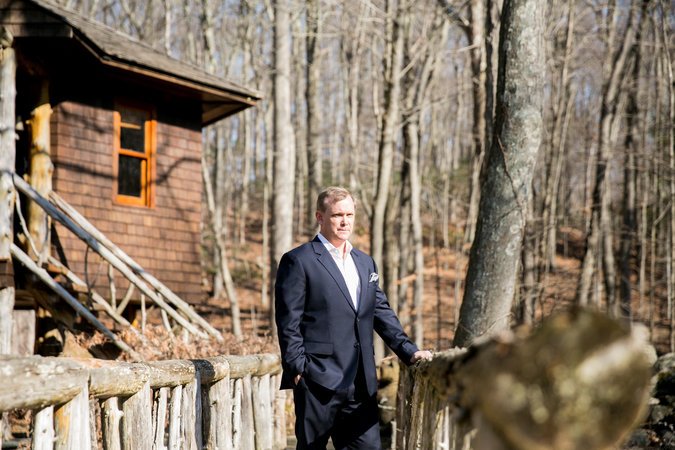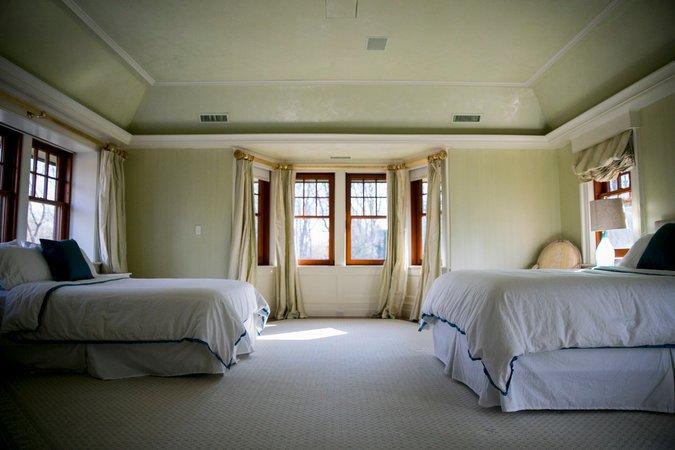After his stay at Silver Hill, Mr. Laird turned to the more traditional support network of recovering addicts. It was then that he got an idea to formalize the support he had been giving and receiving.
“I went to pick up these guys at Silver Hill, and the guy next to me, an accountant from the Midwest, said he was worried about going home,” Mr. Laird said. “That was my signal to go start something with the protection of living in a house where everyone is sober.”

In 2015, he opened the Lighthouse, a luxury sober-living home in Darien for executives. Last year, he opened a second branch in New Canaan. With rates of $10,500 to $17,500 a person a month that are not covered by insurance, these homes are not for people of modest means.
The house in New Canaan is 8,000 square feet and valued at more than $4.5 million. It is decorated like a home in a design magazine; the basement contains a golf simulator.
But Lighthouse homes are more than a comfortable living space; they provide support and accountability for residents who go to work during the day and come back at night. In addition to their counseling and treatment sessions, residents are required to use a Breathalyzer and attend a weekly house meeting.
Other facilities are offering treatment programs aimed at executives.
Silver Hill is starting an executive program in conjunction with the Yale School of Medicine next month. The fees will be a bit less for a private room at Silver Hill, which costs $70,000 to $80,000 a month, said Samuel A. Ball, a professor of psychiatry at Yale’s medical school who will be the program’s director.

Caron Treatment Centers, which runs several recovery programs, has a property in Boca Raton, Fla., called Ocean Drive that bills itself as “a discreet luxury rehab center for people of affluence and influence.” It costs $75,000 for the first month and $65,000 a month after that.
Advertisement
Continue reading the main story
The company’s center outside of Philadelphia has created more specific programs for medical professionals at $50,000 for an average stay of six weeks. For lawyers, the fees are $32,000 for a four-week program and $25,000 for additional months.
Despite the intentions of the programs, their high fees and luxury accommodations have drawn criticism from treatment professionals, who say they walk a fine line between coddling and helping.
“The challenge is if the term ‘executive’ is code for just rich people or someone with a high-powered job,” said Arden O’Connor, chief executive of the O’Connor Professional Group, which consults on treatment plans for addiction and eating disorders.

But she said it was helpful for people entering treatment programs to be around others of the same age and background. Being in the wrong group could make some older executives resistant to the program.
“You send them into a facility with a bunch of 27-year-olds who dropped out of college for IV heroin use, they’re going to say, ‘I’m not as bad as them’ and leave,” she said.
Dr. Ball said the new executive program at Silver Hill would be as rigorous as other programs at the hospital, but with a greater emphasis on programs for individuals. The residents will be allowed to work as long as it did not affect their treatment.
“We’re building, in a structured way, the opportunity for people to continue their connection to their work, to the extent their company allows it,” he said. “These may be executives in the middle of big deals, and they can’t disappear for a month. They can maintain communications, and that differs from other programs.”

Bradley F. Sorte, vice president for Florida operations at Caron, said the company’s tailored programs for doctors and lawyers separated them further from general treatment programs. In the case of doctors, the level of care meets their medical knowledge.
Advertisement
Continue reading the main story
When recovering addicts finish their time at a rehab center, they often go to a sober-living house, where the goal is to be a bridge back to their old lives.
Barry Goldberg, 62, an executive from West Hartford, Conn., said that when he finished his inpatient alcohol treatment at Mountainside in Canaan, Conn., last year, he was not ready to go back to his family and asked to stay at a sober-living house instead.
“They had their own facility there, but it was very young and very opiate-focused,” he said. “It involved having no car, working in a restaurant they owned, and them managing my money. That wasn’t for me. They knew I was a professional.”

He went to the Lighthouse’s Darien location for several months. He said he was busy with meetings and work throughout the day and that helped him stay on track. At night, he ate dinner and shared stories with other residents who had done well in their careers. He finished the program in January.
“I have avoided relapsing,” Mr. Goldberg said. “I attribute that to building a very broad-stroke, diverse program that I stuck with.”
There are certainly criticisms of this elite approach. By default as much as design, such executive-focused programs attract high-functioning addicts, the ones who were able to keep their professional lives together and amass the savings to pay the bill. They are people like Mr. Laird, who rose to the level of managing director at his firm while doing drugs before riding the train to work.
“If you still have your job, you can pull the ripcord at anytime,” said Ariel Eliaz, manager of NYC Sober Living in the Park Slope neighborhood of Brooklyn, which charges $7,500 a month. “There is the financial freedom aspect of it. You feel like you can run off.”
Mr. Eliaz, who also works as an actor, was destitute when he got sober at age 33 in 2012. He understood why executives needed a different environment, but he said for him, the fellowship of other addicts allowed him to enter into and stay in recovery.
What these executive centers provide — somewhere between clinical rehab hospital and five-star resort — is the gray area that some professionals need to get well.
Advertisement
Continue reading the main story
“You’re trying to get someone to put some external motivation on them until there is some internal motivation,” Ms. O’Connor said. “If someone is making all the money in the world and they’re at the pinnacle, and their wife is afraid to say no to them, short of the board of directors saying, ‘You screwed up the last earnings call,’ there is no one else to make that call.”
Continue reading the main story
Article source: https://www.nytimes.com/2018/02/23/your-money/addiction-recovery-executives.html?partner=rss&emc=rss
Speak Your Mind
You must be logged in to post a comment.